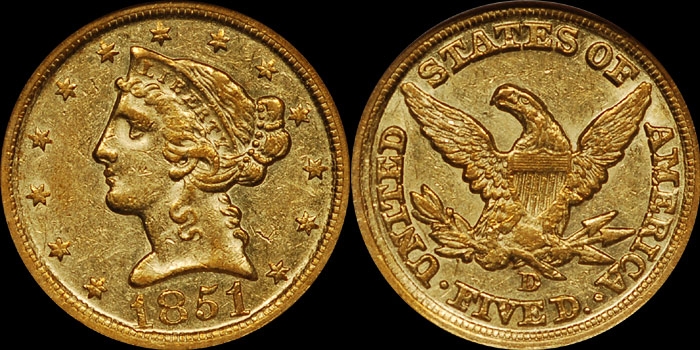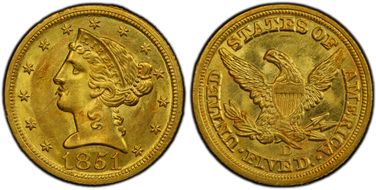1851-D $5 AU58 认证号60167783, PCGS号8248
专家评论
Doug Winter
It is interesting to compare the rarity of the 1851-D half eagle to the 1850-D. The 1850-D is, by a slight margin, the rarer of the two issues in terms of the total number of specimens believed to exist. But the 1851-D is more available in high grades and has a much higher percentage of its known population in high grades (i.e., About Uncirculated-50 or better).The 1851-D half eagle is usually seen in Very Fine and Extremely Fine grades. This date is slightly more available in high grades than one might expect but it is still rare in any grade above About Uncirculated-50. It is extremely rare in Mint State.
STRIKE: The 1851-D is one of the more poorly struck Dahlonega half eagles from the 1850’s. Most are very weakly struck on the curls around the face and below the ear. The rest of the obverse, curiously, is well struck and have some fully defined radial lines in the stars and a sharp date. The reverse is usually very weak on the shield, the legs of the eagle and the claws. The weakness at the centers is sometimes mistaken for wear making the 1851-D a difficult issue to grade. On pieces which are weak at the center, it is important to take into consideration such factors as the remaining luster and the amount of wear visible on the nostril and brow of Liberty. Examples are known that show a weak mintmark. These generally trade at reduced levels in comparison to those with clearly defined mintmarks.
SURFACES: The surfaces often show concentrated, deep abrasions. This is compounded by mint-made problems such as areas of granularity, planchet defects or raised die lines. It is hard to locate an 1851-D half eagle with clean surfaces.
LUSTER: While this is not generally a well made issue, the quality of luster seen on the few higher grade 1851-D half eagles which exist is very good. The luster is frosty in texture.
COLORATION: The coloration on pieces which have not been cleaned or dipped is most often a rich yellow-gold or medium green-gold. Only a small number are known that retain their original coloration.
EYE APPEAL: This date generally has below average eye appeal. This is due to the fact that many have been cleaned or show numerous detracting marks. In addition, most have been cleaned or dipped at one time. Any 1851-D half eagle that has good eye appeal is worth a strong premium.
PERSONAL OBSERVATIONS: Knowledgeable collectors and dealers value Weak D 1851-D half eagles at a significant discount relative to examples with strong mintmarks. Generally speaking, a very high grade 1851-D half eagle with a weak mintmark sells for a greater discount than a lower grade example. An Extremely Fine-45 or lower piece does not show as much of a price difference.
DIE VARIETIES: This is an especially fertile issue for variety collectors. There are at least five die varieties currently known and the possibility exists that some new die combinations may be discovered after they become better known to collectors.
Variety 25-O: On the obverse, the first 1 in the date is free of the denticles and it is positioned in front of the neck. The second 1 in the date is away from the neck. Neither of these digits shows signs of repunching. The reverse is the same as described above for Variety 23-O. Some examples of this variety show a very weak or nearly invisible mintmark.
Variety 25-Q: The obverse is the same as described above. The reverse is notable for having the mintmark positioned far to the right. It is midway in the field between VE in FIVE and the feather. It is located slightly to the right of the midway point of the top of the E in FIVE.
The mintmark is often weakly impressed.
Variety 26-R: On the obverse, the first 1 in the date joins a denticle and it is positioned under the neck. The second 1 in the date is very close to the neck. The base of the first 1 is repunched. The reverse was used only in 1851 and the mintmark is positioned so that its upright is over the left serif of the E in FIVE. The left edge of the mintmark is over the center of the right diagonal of the V in FIVE while the right edge extends to near the right edge of the E. The mintmark is away from both the stem and the feather. The reverse shows the strongest mintmark of any variety of 1851-D half eagle.
Variety 25-R: This variety combines the first of the obverses used in 1851 with the third reverse.
Variety 26-O: This variety combines the second obverse used in 1851 with the first reverse.
It is not yet known which of these varieties is rare and which is common. As more 1851-D half eagles are attributed by collectors, this information should become available.
David Akers (1975/88)
The 1851-D is more common than the 1851-C as a date, but it is just about as hard to obtain better than EF since the overwhelming majority of known specimens are in the Fine to EF range. I have never seen a strictly uncirculated piece but it is likely that that several exist. Most specimens are weakly struck on the hair curls around Liberty's face and on parts of the eagle.
PCGS #
8248
设计师
Christian Gobrecht
边缘
Reeded
直径
21.65 毫米
重量
8.36 克
铸币数量
62710
金属成分
90% Gold, 10% Copper
更高评级数量
7
评级较低的钱币数量
153
地区
The United States of America
价格指南
PCGS 数量报告
拍卖 - PCGS 评级的
拍卖 - NGC 评级的
稀有性和存量估计 了解更多
| 所有评级 | 145 |
| 60或以上 | 4 |
| 65或以上 | 0 |
| 所有评级 | R-7.5 |
| 60或以上 | R-9.8 |
| 65或以上 | R-10.1 |
| 所有评级 | 49 / 112 TIE |
| 60或以上 | 18 / 112 TIE |
| 65或以上 | 1 / 112 |
| 所有评级 | 79 / 218 TIE |
| 60或以上 | 31 / 218 TIE |
| 65或以上 | 1 / 218 |





















